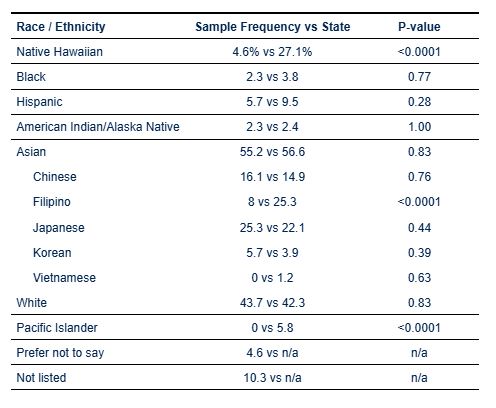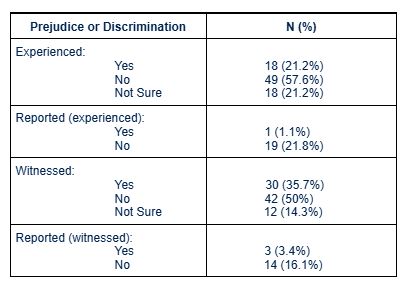Medical Education 7: DEI
Session: Medical Education 7: DEI
456 - Diversity in Hawaiiʻs Pediatric Physician Workforce: Challenges, Bright Spots, and Next Steps
Saturday, April 26, 2025
2:30pm - 4:45pm HST
Publication Number: 456.4288
Maya Maxym, University of Hawaii, John A. Burns School of Medicine, Honolulu, HI, United States; Marissa Fakaosita, University of Hawaii, John A. Burns School of Medicine, Honolulu, HI, United States; Chieko Kimata, Hawaii Pacific Health, Honolulu, HI, United States; Misty Lilinoe N. Smith, University of Hawaii, John A. Burns School of Medicine, Ewa Beach, HI, United States; Selina S. chen, University of Hawaii, John A. Burns School of Medicine, Honolulu, HI, United States; Len Y. Tanaka, University of Hawaii, John A. Burns School of Medicine, Honolulu, HI, United States; Rachel A. Coel, University of Hawaii, John A. Burns School of Medicine, Honolulu, HI, United States; Nanea Cavaco, Kapi'olani Medical Center for Women and Children, Kapolei, HI, United States

Maya Maxym, MD, PhD (she/her/hers)
Assistant Professor, Pediatrics
University of Hawaii, John A. Burns School of Medicine
Honolulu, Hawaii, United States
Presenting Author(s)
Background: Hawai’i has the highest diversity index (76%) in the US; 24% of the population is multiracial. The misconception that Hawai’i is thus more tolerant is common, but Native Hawaiians, Micronesians, other Pacific Islanders, and Filipinos suffer significant discrimination and inequities. Data on the benefits of diversity in the healthcare workforce and medical school leadership is strong. Despite anecdotal observations of a lack of representative diversity, there are currently no available data on the ethnicity or other intersectional identities of pediatric faculty and residents in Hawai'i.
Objective: Our study aims to collect baseline data on race, ethnicity and other identities, as well as experience, witnessing and reporting of discrimination, among pediatric faculty and residents. These data will serve as a needs analysis to guide changes to institutional practices.
Design/Methods: An anonymous survey, designed by members of the Pediatric Diversity, Equity & Inclusion (DEI) Workgroup with input from experts and institutional leadership, was emailed to faculty and residents. We intentionally sought disaggregated ethnicity data and asked about various types of diversity. Each category was summarized with descriptive statistics using frequency and percentage. Fisher's exact test was used to compare our population to state-level data and test the differences between types of prejudice or discrimination experienced or witnessed.
Results: Response rate was 30%. Table 1 shows the race/ethnicity of respondents compared to state-level data. Native Hawaiians, other Pacific Islanders, and Filipinos were markedly underrepresented, though more residents than faculty (15.8% vs 1.5%, p=0.03) are Native Hawaiian. There was no difference in how many respondents identify as LGBTQ+ or are from a low-income background compared to state demographics. Residents reported a mental health disability more than faculty (21.1% vs 2.9%, p=0.019). Rates of other disabilities were comparable between groups. Table 2 shows respondents who experienced or witnessed prejudice or discrimination in the workplace and reporting rates. Figure shows the breakdown of types of prejudice or discrimination.
Conclusion(s): We highlight the work of a local DEI workgroup in obtaining critical baseline diversity and discrimination data. We found low rates of discrimination based on sexual orientation and gender identity but high rates based on gender and race/ethnicity, as well as marked underrepresentation of minoritized groups. Transparent data sharing will help direct initiatives to increase diversity, promote a culture of belonging, & improve reporting.
Table 1: Pediatric faculty and resident race and ethnicity compared to state-level data
 Native Hawaiian, Filipino, and Other Pacific Islander physicians are dramatically under-represented in our faculty and residents as compared to State of Hawai'i demographics. Source: State-level data was taken from the State of Hawaii Department of Business, Economic Development, and Tourism 2021 Detailed Race Characteristics Report (https://dbedt.hawaii.gov/economic/detailed-race-characteristics_acs2021/). One exception was state-level data for Hispanic or Latino/a/x ethnicity, which was taken from the 2020 US Census (https://www.census.gov/library/stories/state-by-state/hawaii-population-change-between-census-decade.html).
Native Hawaiian, Filipino, and Other Pacific Islander physicians are dramatically under-represented in our faculty and residents as compared to State of Hawai'i demographics. Source: State-level data was taken from the State of Hawaii Department of Business, Economic Development, and Tourism 2021 Detailed Race Characteristics Report (https://dbedt.hawaii.gov/economic/detailed-race-characteristics_acs2021/). One exception was state-level data for Hispanic or Latino/a/x ethnicity, which was taken from the 2020 US Census (https://www.census.gov/library/stories/state-by-state/hawaii-population-change-between-census-decade.html).Table 2: Prejudice or discrimination experienced or witnessed by pediatric faculty and residents with reporting rates
 A significant minority of all respondents had experienced or witnessed one or more types of prejudice or discrimination, but reporting rates were exceedingly low for both categories.
A significant minority of all respondents had experienced or witnessed one or more types of prejudice or discrimination, but reporting rates were exceedingly low for both categories.Figure: Types of discrimination or prejudice experienced or witnessed by respondents
.jpg) Most common types of discrimination or prejudice experienced by respondents included race/ethnicity and gender. While all categories were represented in witnessed types of prejudice or discrimination, notable differences between experienced and witnessed included statistically significantly higher percentages of prejudice or discrimination based on gender identity / expression, socioeconomic status, educational background, and non-native English speaker / country of origin.
Most common types of discrimination or prejudice experienced by respondents included race/ethnicity and gender. While all categories were represented in witnessed types of prejudice or discrimination, notable differences between experienced and witnessed included statistically significantly higher percentages of prejudice or discrimination based on gender identity / expression, socioeconomic status, educational background, and non-native English speaker / country of origin. 
